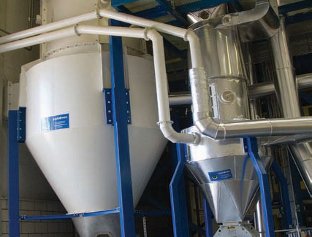Instalmec's Fibre Cleaner Improves Mdf
29 August 2017Instalmec is another of those North Italian companies whose passion for engineering and whose genius for design help shape the machinery of the panels industry. A new cleaner for wood Fibre is their latest innovation, as Julian Champkin discovered
Instalmec is based in Udine, at the very top of the Adriatic, close to the border with Slovenia. A 40-year-old company, its specialities are the treatment of recycled and waste wood in the wood based panel industry, including hammer mills; drying systems for particle board production; and dust and exhaust gas extraction systems from its combustion chambers.
But re-cycling is its special interest, almost passion. When WBPI met the company's founder, Adriano Stocco, at Ligna, he held us spellbound by enthusing about the quality of panels that can now be produced from re-cycled wood, and how the quality is higher and prices lower than for panels from virgin wood.
Italy, with a national shortage of forest, a national demand for panels and a national mindset that is in love with engineering, has been at the forefront of developing networks to deliver waste wood from city recycling centres to panel makers and others who can use the material.
Recycled wood comes in to the mills at a much lower humidity than fresh wood, which saves on drying cost. It does, though, have impurities. Hardly surprising, then, that Mr Stocco and his company are proud of their new mineral cleaner, which enhances the quality of panel surfaces thanks to a drastic reduction in mineral content and sand in recovered waste wood. Kronospan seems equally impressed. It has installed an Instalmec system at its new plant at Burgos which produces particleboard panels from 100% recycled wood chips.
Almost all MDF production lines, says Mr Stocco – 98% of them if you want a figure – have a common problem: small, black spots on the surface of the panels. They are due to foreign substances such as rubber, glue lumps and dirt incorporated in the wood fibre.
Instalmec has been studying and working on the problem for several years. Now the company can offer a cutting-edge technology for separating these contaminants from the fibre before it goes to the press. "Our technology operates in two steps. It reaches a much higher classification efficiency than traditional systems available on the market," says Mr Stocco. Hence they call it the High Efficiency Fibre Sifter.
Fan cleaners have been available on the market; but uniquely, in the Instalmec cleaning system, the fibre does not pass through the fan. The fibre therefore does not directly contact the fan blades, which brings a large advantage: the fibre keeps its original structure and is not broken down into smaller particles. The result is a panel whose mechanical characteristics are much higher than the average for MDF.
The functioning principle of the machine is a two-stage density-based winnowing process, assisted by gravity. In the first stage a large pre-sifter processes the whole amount of incoming fibre and divides it into two fractions: the clean fibre (around 95 %) and the uncertain fraction (around 5%), containing rejects mixed with a certain quantity of fibre of good quality.
In the second step, a small post-sifter processes the uncertain fraction rejected during the first step and again separates it into two fractions: the rejected material and the recovered good-quality fibre.
In each of the sifters the wood fibre to be cleaned is introduced from the top through a group of special spreading rollers.These are specially designed to give a uniform dispersion and distribution of the fibre at the inlet of the sifter.
The fibre falls by gravity into a wellcontrolled upward-blowing current of air.
The material floats in the air flow until it is sorts itself by density.
Heavier material includes balls of fibre (denser due to glue lumps and/or humidity), coarser fibre (denser because not well refined by the spreading rolls) and impurities and foreign bodies such as particles of metal or plastic. These denser elements fall down and are rejected at the bottom of the pre-sifter. Clean material is pneumatically conveyed to the discharging cyclone placed above the forming line.
The heavy material – the so-called uncertain fraction – rejected at the bottom of the pre-sifter also contains a certain quantity of fibre of good quality which can be recovered by means of a Post-sifter.
The Post-sifter works on the same principle as the pre-sifter, but is pneumatically independent from it and the setting parameters are different.
The air flows of the two sifters are set by means of regulating gates and frequency converters in order to precisely adjust the air speed and obtain the desired degree of separation from contaminants.
Most of the airflows are re-circulated and only a small percentage of the air is sent to the dryer inlet.
In addition to the pre- and post-sifter, the device is provided with innovative Low Pressure Drop (LPD) cyclones, patented by Instalmec. These have the advantage of much lower electric energy consumption in the motor of the fan and a high resistance to wear. Thanks to the compact design, these cyclones are smaller than traditional ones and can be installed indoors, which is another considerable advantage.
The fibre cleaner is very easily and precisely adjustable, according to the level of desired cleaning efficiency. The removal of fibre-balls, coarse fibre, impurities and foreign bodies not only improves the panel quality and its surfaces; it also assures protection of the steel belt of the press.
The advantages, then, of the Instalmec system are much greater efficiency, provided by the two-stage system; protection of the steel press band; improved panel quality and surface, and hence increased productivity of first quality boards; and, finally, low production costs and compact installation. That Italian passion for recycling and engineering evidently brings rewards
